A visit to the modern district of EUR gives travelers a good look at the visions of the former Italian Fascist leader, Benito Mussolini. EUR was built in the 1930s as a showcase of Fascist architecture.
Its History
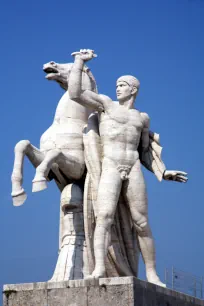
Mussolini had a passion for large building projects, and in 1935 he envisioned a whole new modern city center that would stretch all the way to Ostia. This expansion of Rome was meant to rival the old city center built by the Roman emperors and popes.
The area dubbed EUR, short for Esposizione Universale di Roma, was meant to become the monumental gateway to this new city. It was built on the occasion of the World Exhibition of 1942 which coincided with the twentieth year of the regime of dictator Mussolini. The project for the creation of EUR – at the time known as E42 – was planned by architect Marcello Piacentini. Construction started in 1938 and over a span of just three years, whole city blocks with monumental marble palaces rose from the ground, complete with statues and colonnades.
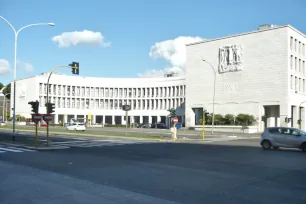
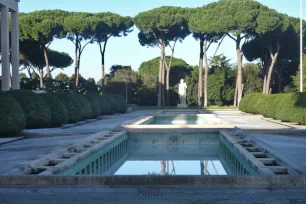
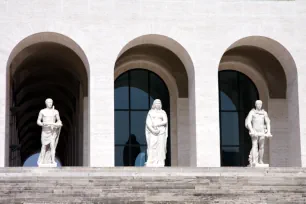
The exposition was eventually cancelled because of the war. For years, the area was completely abandoned, and the half-completed buildings stood in a desolate no man’s land. However, in the 1950s work on the buildings continued, absent of Mussolini’s political agenda, and EUR evolved into a modern business district.
EUR Today
Fascist architecture was influenced by the architecture of the Romans, but the modern palaces look soulless and bland, and the atmosphere in EUR can’t compare with the historic center of Rome. But as an urban project, EUR can be considered reasonably successful: it is popular with residents thanks to its open layout with wide streets and easy accessibility.
What to see in EUR
Visitors are mostly attracted to the unique 1930s architecture and the handful of museums that can be found here. The Museo della Civiltà Romana, with its scale model of Imperial Rome and plaster casts of the Column of Trajan, is worth a visit to EUR on its own.
If neither modern architecture nor museums are of any interest to you, it might be better to avoid EUR altogether. The area has many large office buildings, but you won’t find many cafés, restaurants or even shops here.
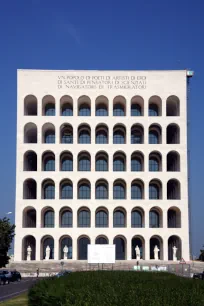
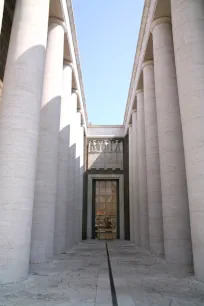
Square Colosseum
The largest and most famous building of EUR is the “square Colosseum”, known in Italian as the Palazzo della Civiltà di Lavoro (Palace of the civilization of Labor), a supposed nod to the achievements of the Italians.
The building was to be the centerpiece of the exposition of 1942. Its 216 arches were meant to mirror Rome’s famous Colosseum. Around the building and in the arches on the lower level stand marble statues created in typical Fascist style. The statues in the arches are allegorical representations of different professions and industries. The statues placed around the Square Colosseum depict the Dioscuri.
Museums
Visitors will find a small cache of museums in EUR, most of which are rarely visited due to their remote location. The most notable is the Museo della Civiltà Romana where you’ll find an interesting scale model of Imperial Rome among other exhibits touting the history of the city. The building also houses a planetarium.
The neighboring Museo Nazionale Preistorico Etnografico features a large and diverse collection of African, Chinese and American handicrafts. In the same building is the Museo Nazionale dell’Alto Medioevo (National Museum of the Early Middle Ages), with a collection of artifacts and treasures from the fourth to the tenth century, including many golden and silver objects.
Another museum in EUR is the Museo Nazionale delle Arti e Tradizioni Populari (National Museum of the Arts and Traditions of Rome) which shows a collection of costumes, flags, musical instruments and art from the different regions of Italy.
Other notable buildings
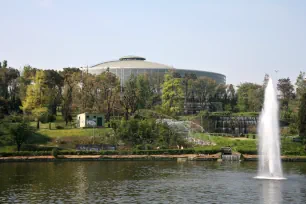

The round, UFO-shaped building near EUR’s large lake is the former Palazzo dello Sport. It was built in 1956-1960 by Marcello Piacentini and Pier Luigi Nervi for the 1960 Olympics.
Today, the stadium is a multi-functional complex known as the Palalottomatica. The building can accommodate 12,000 visitors and hosts not only sporting events, but concerts and congresses as well. Near the lake is a pleasant park with a series of cascades.
Also in the midst of EUR is the Palazzo dei Congressi (Palace of Congresses), a low-domed building designed by architect Adalberto Libera in what is now known as a rationalist style. The building was meant to reflect the architecture of the Pantheon. Construction started in 1938, but it was only completed after the war, in 1954. Today, the marble building is still used as a congress center. One of the unique features of the Palazzo dei Congressi is its outdoor amphitheater on the second floor.
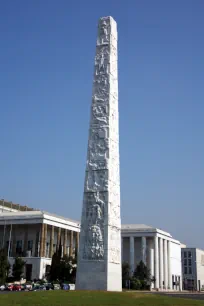
A modern church, the Santi Pietro e Paolo (Sts. Peter and Paul), is said to have been modeled on St. Peter’s at the Vatican, but it lacks both in size and grandeur. Construction of the church started in 1939 and after a hiatus due to the war it was completed in 1955. It is said that Benito Mussolini had planned this church as his own mausoleum.
In the middle of Piazza Marconi, you’ll find an obelisk structure dedicated to Guglielmo Marconi, an inventor known for his ground-breaking work in radio transmissions. The forty-five-meter-tall (148 ft.) obelisk in white marble was built in 1959 for the 1960 Olympics in Rome. The panels display scenes in the life of Marconi.

